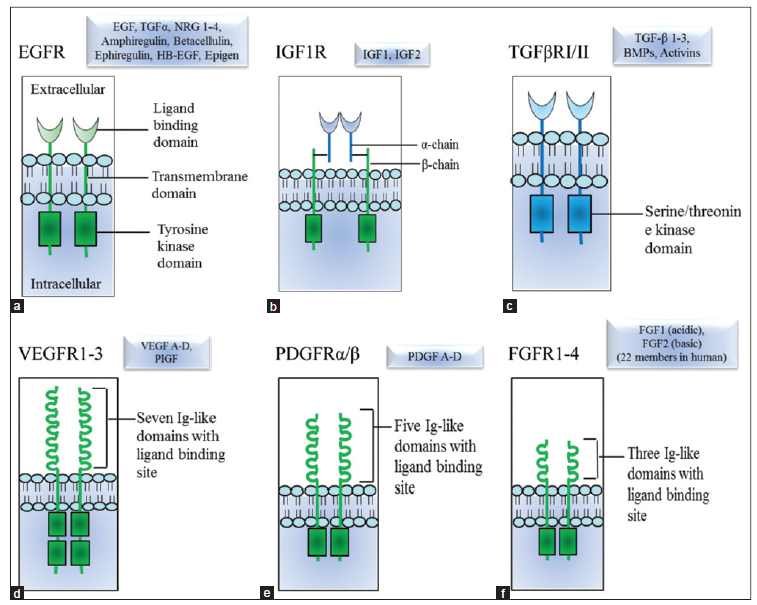

Oncoprotein-Growth Factor Receptors
Growth factor receptors play an important role not only in the creation of cancers but also as intermediate factors in cellular proliferation, differentiation, and survival via a complicated snowballing of signals. They belong to the class of integral membrane proteins and adhere specifically to characteristic growth factors, thus relaying intracellular signaling cascades for cellular proliferation and viability. For these pathways to work under normal physiological conditions, it follows that the signaling of the pathways is in general rigidly controlled so that normal cellular homeostasis can be safely carried out. This can also be seen in the case of cancer when changes in receptors of growth factors or their associated downstream signaling pathways lead to unrestrained cellular growth and evasion of apoptosis, two scenarios needed in cancer genesis. Mutations, overexpression, or constitutive activation of such receptors may result in too much stimulation by proliferative signals, even at times when such growth factors are not present. This family incorporates, for example, the Epidermal Growth Factor Receptor (EGFR) family that has had a large impetration in playing pivotal roles in the promotion of tumorigenesis and metastasis of lung, colorectal and breast cancers. The VEGF receptors are a part of the angiogenesis system followed by supplying a tumor with blood supply to keep it nourished with nutrients and oxygen. These are therapeutic strategies in oncology in which growth factor receptors have varieties developed to either target the development of these receptors or that of the receptor ligands to block the development of the oncogenic signaling pathways.
 Figure 1 Membrane bound growth factor receptors and their ligands involve in cancer progression. (Tiash, 205)
Figure 1 Membrane bound growth factor receptors and their ligands involve in cancer progression. (Tiash, 205)
Representative Growth Factor Receptors
FGFR1
FGFR1 (fibroblast growth factor receptor 1) is a receptor tyrosine kinase that belongs to the receptor family of transmembrane tyrosine-type kinases. Concerning regulation at the level of developmental processes—be that of differentiation, migration, and finally, control of cell proliferation—it stands right in the middle in regulation. The activation of an appropriate receptor, be it FGFR1, upon binding to the ligands, which are the fibroblast growth factors (FGFs), sets in motion such a symphony of cascading major downstream signaling pathways, most notably including RAS/MAPK, PI3K/AKT, and PLCγ, importantly guiding cellular development homeostasis. FGFR1 encodes for the receptor expressed in different tissues and organ systems and is requisite for normal ontogeny, tissue repair, angiogenesis, and neurogenesis in an epistatic relationship. On the other hand, changes in the expression and/or function of FGFR1 do occur in many pathological states of the skeletal system, in developmental syndromes, and in cancer. In oncology, FGFR1 mutation or amplification also might drive tumorigenesis by recruitment to uncontrolled cell growth and survival, the basis for therapeutic targeting in cancer.

FGFR2
Fibroblast growth factor receptor 2 (FGFR2) is a critical component of the FGFR family, it acts as a basic molecule in the signaling cascade related to cellular functions like proliferation, differentiation, and survival. Similarly to FGFR1, FGFR2 binds to these factors and afterwards activates a number of intracellular signaling cascades that include certain of the cascade members of the MAPK, PI3K-AKT, and PLCγ cascades, all important in embryogenesis and maintenance of the adult tissue. The above studies show that FGFR2 has variably been showed to be expressed within different tissues, within embryos, it just even been showed to be essential to limb development, skin formation, and the mammary gland. In the case of FGFR2, mutations or upregulation will be either associated with syndromic and other neoplastic conditions in a wide-range of developmental syndromes of skeletal abnormality, as in Apert, Crouzon, and Pfeiffer syndromes, as in carcinogenesis, an inappropriate FGFR2 signal causes types of breast, gastric, and lung cancers, promoting proliferation of the tumor, resistance to apoptosis, invasion, and metastasis.

c-KIT
The c-KIT (also known as KIT) gene codes for one of the receptor tyrosine kinases, most usually acknowledged as CD117 in the cellular network, for nearly all animal species, being principally the mammalian types. Its function is in transduction, growth, and differentiation. Since this receptor is the most common for the variety of normal developments of some cell lineages, such as melanocytes, germ cells, and hematopoietic cells, it is therefore regarded. Upon binding to the ligand, the stem cell factor, c-KIT leads to the dimerization and subsequently the transduction of intrinsic kinase activity, which leads to a kinase cascade of signaling pathways with a variety of biological activities, promoting cell survival, proliferation, and migration. This complex signaling mechanism lies at the base to underline the importance of c-KIT in process. However, in obviously logical correspondence with its mentioned paramount importance throughout normal physiological life activity, mutations and an unbalance of c-Kit are implicated in pathogenesis of a wide spectrum of diseases, to name few, including gastrointestinal stromal tumors, some leukemias, and also melanomas.



Full List of Growth Factor Receptors
Tested Data-Supported Products for Growth Factor Receptors
- Tiash, Snigdha, and Ezharul Hoque Chowdhury. "Growth factor receptors: promising drug targets in cancer." J. Cancer Metastasis Treat 1 (2015): 190-200.
For research use only. Not intended for any clinical use.
This site is protected by reCAPTCHA and the Google Privacy Policy and Terms of Service apply.
